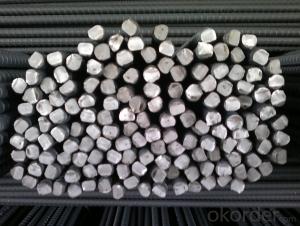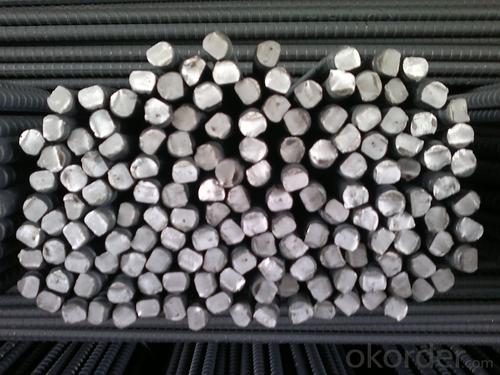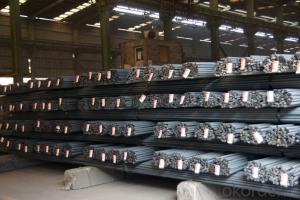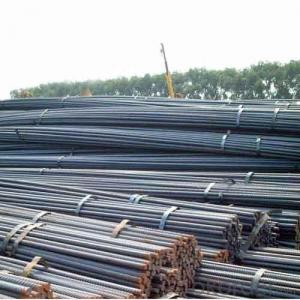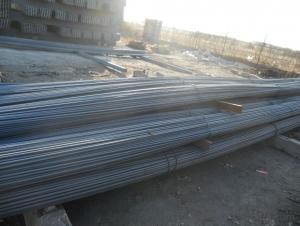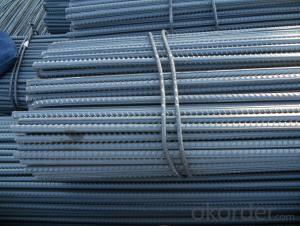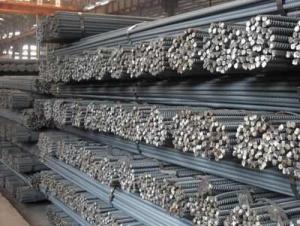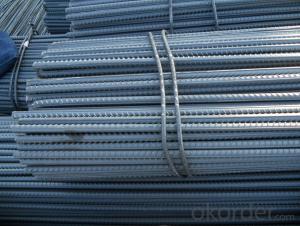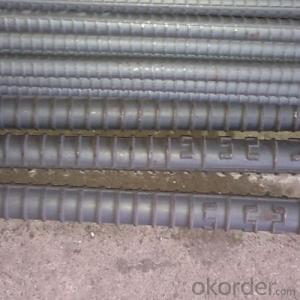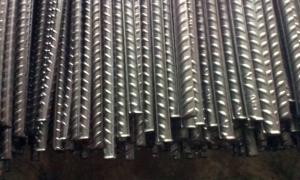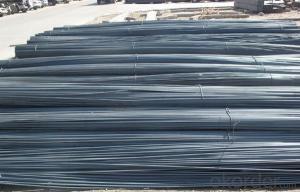Deformed Steel Bars All Size Steel Rebars with high quality
- Loading Port:
- Tianjin
- Payment Terms:
- TT or LC
- Min Order Qty:
- 50 m.t
- Supply Capability:
- 20000 m.t/month
OKorder Service Pledge
OKorder Financial Service
You Might Also Like
Product Description:
OKorder is offering Deformed Steel Bars All Size Steel Rebars with high qualityBuilding Material China Manufacturer at great prices with worldwide shipping. Our supplier is a world-class manufacturer of steel, with our products utilized the world over. OKorder annually supplies products to European, North American and Asian markets. We provide quotations within 24 hours of receiving an inquiry and guarantee competitive prices.
Product Applications:
Deformed Steel Bars All Size Steel Rebars with high quality,Building Material China Manufacturer are ideal for structural applications and are widely used in the construction of buildings and bridges, and the manufacturing, petrochemical, and transportation industries.
Product Advantages:
OKorder's Deformed Steel Bars All Size Steel Rebars with high quality,Building Material China Manufacturer are durable, strong, and resist corrosion.
Main Product Features:
· Premium quality
· Prompt delivery & seaworthy packing (30 days after receiving deposit)
· Mill test certification
· Professional Service
· Competitive pricing
Product Specifications:
commodity:deformed steel bars
2.grade:ASTM A615 HRB335 HRB400 HRB500 BS4449 grade460
3.size:6#-32#
4.length:6m 9m 12m
We henglong can offer high quality deformed steel bar
grade:ASTM A615 BS4449 GRADE460 HRB335 HRB400 HRB500
size:6# to 32#
length:6M 9M 12M
Chemistry % | |||||||||||||
Designation | Chief component | Impurities maxmium | |||||||||||
Ta | Nb | Fe | Si | Ni | W | Mo | Ti | Nb | O | C | H | N | |
Ta1 | Remainder | 0.004 | 0.003 | 0.002 | 0.004 | 0.004 | 0.002 | 0.03 | 0.015 | 0.004 | 0.0015 | 0.002 | |
Ta2 | Remainder | 0.01 | 0.01 | 0.005 | 0.02 | 0.02 | 0.005 | 0.08 | 0.02 | 0.01 | 0.0015 | 0.01 | |
Permissible variations in diameter for rods
Diameter, inch (mm) | Tolerance, +/-inch (mm) |
0.125~0.187 excl (3.175~4.750) | 0.003 (0.076) |
0.187~0.375 excl (4.750~9.525) | 0.004 (0.102) |
0.375~0.500 excl (9.525~12.70) | 0.005 (0.127) |
0.500~0.625 excl (12.70~15.88) | 0.007 (0.178) |
0.625~0.750 excl (15.88~19.05) | 0.008 (0.203) |
0.750~1.000 excl (19.05~25.40) | 0.010 (0.254) |
1.000~1.500 excl (25.40~38.10) | 0.015 (0.381) |
1.500~2.000 excl (38.10~50.80) | 0.020 (0.508) |
2.000~2.500 excl (50.80~63.50) | 0.030 (0.762) |
FAQ:
Q1: How do we guarantee the quality of our products?
A1: We have established an advanced quality management system which conducts strict quality tests at every step, from raw materials to the final product. At the same time, we provide extensive follow-up service assurances as required.
Q2: How soon can we receive the product after purchase?
A2: Within three days of placing an order, we will begin production. The specific shipping date is dependent upon international and government factors, but is typically 7 to 10 workdays.
Q3: What makes stainless steel stainless?
A3: Stainless steel must contain at least 10.5 % chromium. It is this element that reacts with the oxygen in the air to form a complex chrome-oxide surface layer that is invisible but strong enough to prevent further oxygen from "staining" (rusting) the surface. Higher levels of chromium and the addition of other alloying elements such as nickel and molybdenum enhance this surface layer and improve the corrosion resistance of the stainless material.
Images:
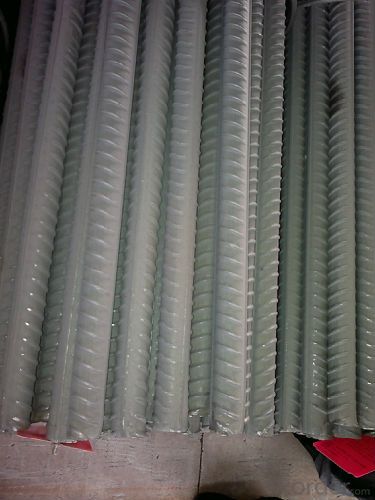
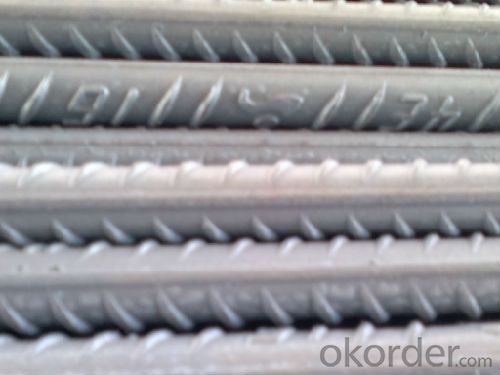
- Q: How are steel rebars cut and shaped on-site?
- Steel rebars are typically cut and shaped on-site using handheld tools such as rebar cutters and benders. Rebar cutters are used to accurately cut the rebars to the required length, while rebar benders are used to shape the rebars into various configurations such as bends, hooks, or stirrups. These tools allow construction workers to customize the rebars according to the specific needs of the project, ensuring a precise and efficient installation.
- Q: What are the maintenance requirements for steel rebars in a structure?
- The maintenance requirements for steel rebars in a structure are crucial to ensure the stability and longevity of the building. Steel rebars, also known as reinforcing bars, are used to enhance the strength of concrete structures and resist tension forces. Here are some key maintenance requirements to consider: 1. Visual Inspection: Regular visual inspections should be conducted to detect any signs of corrosion, cracks, or damage in the rebars. This can be done by qualified personnel who have knowledge and experience in identifying structural issues. 2. Cleaning: The rebars should be kept clean from any debris, dirt, or chemicals that can accelerate corrosion. Adequate cleaning methods, such as using water and mild detergents, should be employed to maintain their condition. 3. Corrosion Protection: Steel rebars are susceptible to corrosion, especially in environments with high humidity, exposure to saltwater, or chemical pollutants. Applying protective coatings like epoxy or zinc can help prevent or delay corrosion, increasing the rebars' lifespan. 4. Repair or Replacement: If any rebars are found to be severely corroded, cracked, or damaged, it is essential to repair or replace them promptly. Ignoring these issues can compromise the structural integrity of the building and lead to safety hazards. 5. Monitoring: Continuous monitoring of the rebars' condition is recommended to detect any changes or deterioration over time. This can involve using advanced techniques like ultrasonic testing or electrical potential measurements to assess the rebars' integrity. 6. Proper Drainage: Ensuring proper drainage systems in the structure can help prevent water accumulation and reduce the chances of corrosion in the rebars. Properly designed and maintained gutters, downspouts, and waterproofing measures can help minimize water exposure. 7. Regular Maintenance Schedule: Establishing a regular maintenance schedule is crucial to ensure that all the necessary inspections, cleaning, and repairs are carried out systematically. This helps in identifying potential issues early on and taking corrective actions promptly. By adhering to these maintenance requirements, the steel rebars in a structure can be preserved, contributing to the overall safety, durability, and longevity of the building. Regular maintenance not only prevents costly repairs but also ensures the structural integrity required for the safety of occupants and the longevity of the structure.
- Q: What are the different types of corrosion protection coatings for steel rebars?
- There are several types of corrosion protection coatings available for steel rebars, each offering different levels of protection and durability. 1. Epoxy Coatings: Epoxy coatings are one of the most common and effective corrosion protection coatings for steel rebars. They provide a thick, durable barrier that prevents moisture and corrosive substances from reaching the steel surface. Epoxy coatings can be applied by spray, brush, or dip methods and provide excellent adhesion and resistance to chemicals. 2. Zinc Coatings: Zinc coatings, such as hot-dip galvanization or zinc-rich paint, are another popular choice for corrosion protection. These coatings create a sacrificial barrier, where the zinc corrodes instead of the steel rebar. Zinc coatings are highly effective in preventing corrosion, even in harsh environments, and can be applied in various thicknesses depending on the level of protection required. 3. Fusion-Bonded Epoxy (FBE) Coatings: FBE coatings are commonly used in underground or submerged applications. These coatings are applied by heating the steel rebar, which causes the epoxy powder to melt and bond to the surface. FBE coatings provide excellent corrosion resistance and are resistant to chemicals, abrasion, and impact. 4. Polymer Coatings: Polymer coatings, such as polyurethane or polyethylene, are often used in high-temperature environments or where chemical resistance is required. These coatings provide a protective barrier that is resistant to UV radiation, abrasion, and chemicals. Polymer coatings can be applied by spray or dip methods and offer good adhesion to the steel surface. 5. Concrete Coatings: In reinforced concrete structures, the concrete itself can act as a corrosion protection coating for the steel rebars. The high alkalinity of concrete creates a protective layer around the steel, known as the passivating layer, which helps prevent corrosion. Additionally, the use of corrosion inhibitors in the concrete mix can enhance the corrosion protection of steel rebars. It is important to select the appropriate corrosion protection coating based on the specific environmental conditions, intended application, and required durability. Consulting with experts or engineers experienced in corrosion protection can help determine the most suitable coating for steel rebars in a given situation.
- Q: How do steel rebars affect the overall durability of concrete?
- Steel rebars significantly improve the overall durability of concrete. By reinforcing the concrete, rebars enhance its tensile strength, preventing cracking and structural failure. They also provide resistance against shrinkage and expansion caused by temperature changes, ensuring the longevity and stability of concrete structures.
- Q: How are steel rebars connected or spliced together?
- Steel rebars are typically connected or spliced together using overlapping or mechanical splicing techniques. Overlapping involves placing the rebars next to each other and overlapping their lengths to create a continuous and interconnected structure. Mechanical splicing, on the other hand, utilizes couplers or connectors that are threaded or bolted onto the ends of the rebars, effectively joining them together. Both methods ensure a strong and secure connection, enhancing the structural integrity of reinforced concrete.
- Q: What are the different methods for reinforcing concrete with steel rebars?
- Some of the different methods for reinforcing concrete with steel rebars include placing the rebars in a grid pattern throughout the concrete structure, using stirrups or ties to hold the rebars in place, and using pre-fabricated mesh or rebar mats as a convenient way to reinforce large areas of concrete. Additionally, epoxy-coated rebars can be used to protect against corrosion and increase the longevity of the reinforced concrete.
- Q: How do steel rebars perform in fire-resistant constructions?
- Steel rebars perform well in fire-resistant constructions due to their inherent properties. The use of steel rebars in these constructions helps to enhance the fire resistance of the structures. Steel is known for its high melting point and excellent heat transfer properties, making it a reliable material in fire situations. When exposed to high temperatures, steel rebars do not combust or release toxic fumes, which is crucial for ensuring the safety of occupants during a fire incident. Moreover, steel rebars have a low coefficient of thermal expansion, meaning they do not expand significantly when heated. This property helps to maintain the structural integrity of fire-resistant constructions, preventing potential structural failures during a fire. Additionally, steel rebars possess high tensile strength, which contributes to the overall performance of the structure under fire conditions. This strength allows the rebars to resist the forces generated by the expansion of concrete due to heat, thus minimizing the risk of cracking or spalling. Furthermore, steel rebars can be encased in fire-resistant materials such as concrete and fireproof coatings to provide an extra layer of protection against fire. This combination of steel and fire-resistant materials creates a robust system that effectively withstands high temperatures and prolongs the structural stability of the construction in the event of a fire. In conclusion, steel rebars play a vital role in fire-resistant constructions. Their high melting point, low thermal expansion, and excellent tensile strength make them a reliable choice for enhancing the fire resistance of structures. By incorporating steel rebars in construction designs, the safety and durability of buildings are significantly improved, providing occupants with valuable time to evacuate and minimizing the potential for structural damage during a fire incident.
- Q: Can steel rebars be replaced with other reinforcement materials?
- Yes, it is possible to replace steel rebars with other materials for reinforcement. Steel rebars have been widely used in construction due to their strength and durability, but there have been advancements in alternative materials that offer comparable or even enhanced properties. One such alternative is the use of fiber-reinforced polymer (FRP) bars. These bars are composed of high-strength fibers embedded in a polymer matrix. FRP bars possess qualities such as lightweightness, corrosion-resistance, and high tensile strength, making them an appealing substitute for steel rebars. Additionally, they are non-conductive and non-magnetic, which makes them suitable for applications in areas with electromagnetic interference or in industries that require sensitivity to electronics. Another alternative is carbon fiber reinforced polymer (CFRP) bars, which are similar to FRP bars but are specifically reinforced with carbon fibers. CFRP bars offer even greater tensile strength and stiffness compared to steel rebars, making them particularly well-suited for structures that necessitate exceptional load-bearing capabilities. Moreover, natural fiber reinforced composites (NFRC) have been explored as an alternative to steel rebars. NFRC can be created using materials such as bamboo, jute, or sisal fibers embedded in a matrix material like cement or polymer. These natural fibers provide good tensile strength and can be a sustainable and cost-effective substitute for steel rebars, especially in regions where these fibers are readily available. In conclusion, although steel rebars have traditionally been the go-to choice for reinforcement materials in construction, alternatives such as FRP bars, CFRP bars, and NFRC can serve as viable replacements. The selection of reinforcement material depends on various factors including structural requirements, environmental conditions, and cost-effectiveness.
- Q: What are the common methods of cutting steel rebars on construction sites?
- Cutting steel rebars on construction sites involves several common methods, each chosen based on project requirements and available equipment. One commonly chosen method is the use of a rebar cutter. This handheld tool, specifically designed for cutting steel rebars, is operated manually and can easily cut through rebars of varying diameters. Its portability and ease of use make it convenient for on-site applications. Another method involves the use of a chop saw, also known as a cut-off saw or an abrasive saw. This technique utilizes a high-speed abrasive disc to make precise cuts on the steel rebars. Chop saws are ideal when accurate and clean cuts are needed, especially when multiple rebars must be cut to the same length. Oxy-fuel cutting presents another option for cutting steel rebars. This method employs a torch that combines oxygen and a fuel gas, typically acetylene, to create a high-temperature flame. The intense heat generated by the torch effectively cuts through steel rebars of varying thicknesses. Oxy-fuel cutting is particularly useful when rapid cutting or dealing with thicker rebars is necessary. Plasma cutting, a popular method, utilizes a high-velocity jet of ionized gas called plasma to melt and remove the metal. This technique is suitable for cutting rebars of different thicknesses and achieves precise and clean cuts. It is commonly employed when working with rebars that have intricate shapes or when fast and accurate cutting is required. It is essential to adhere to safety precautions when cutting steel rebars on construction sites. These precautions include wearing appropriate personal protective equipment, such as safety glasses, gloves, and hearing protection. Moreover, proper training and supervision are crucial to ensure the correct use of cutting equipment and minimize the risk of accidents or injuries.
- Q: What is the role of steel rebars in ensuring occupant safety?
- Steel rebars play a crucial role in ensuring occupant safety in various structures, particularly in buildings and infrastructure. These reinforced steel bars are commonly used in concrete construction to enhance the strength and durability of the structure, ultimately safeguarding the individuals residing or working within them. The primary function of steel rebars is to provide structural reinforcement to concrete elements, such as columns, beams, and slabs. By incorporating rebars into the concrete, the overall load-bearing capacity of the structure is significantly increased, allowing it to withstand various external forces and loads. This greatly reduces the risk of collapse or structural failure, which could potentially harm the occupants. During seismic events, such as earthquakes, steel rebars play a critical role in dissipating and distributing the energy exerted on the structure. The ductility and tensile strength of steel allow it to absorb and distribute the seismic forces, reducing the chances of a sudden structural failure. This ensures that the occupants are protected from the potential hazards associated with seismic activity. Moreover, steel rebars enhance the fire resistance of concrete structures. While concrete itself possesses good fire-resistant properties, the inclusion of steel rebars further reinforces this resistance. Steel has a high melting point, and its thermal conductivity is relatively low compared to other materials. This means that steel rebars can withstand high temperatures for an extended period, ensuring the structural integrity of the building during a fire and providing occupants with a safe evacuation route. In addition to their structural benefits, steel rebars also contribute to the long-term durability and maintenance of the structure. By preventing cracks and minimizing the effects of corrosion, rebars help maintain the structural integrity of the concrete over time. This ensures that the occupants are not exposed to potential hazards caused by the deterioration of the structure. Overall, the role of steel rebars in ensuring occupant safety is indispensable. They provide structural reinforcement, increase load-bearing capacity, enhance fire resistance, and contribute to the long-term durability of a structure. By incorporating steel rebars into concrete construction, the risk of collapse, structural failure, and other potential hazards is significantly reduced, ultimately providing a safe environment for the occupants.
Send your message to us
Deformed Steel Bars All Size Steel Rebars with high quality
- Loading Port:
- Tianjin
- Payment Terms:
- TT or LC
- Min Order Qty:
- 50 m.t
- Supply Capability:
- 20000 m.t/month
OKorder Service Pledge
OKorder Financial Service
Similar products
Hot products
Hot Searches
Related keywords
